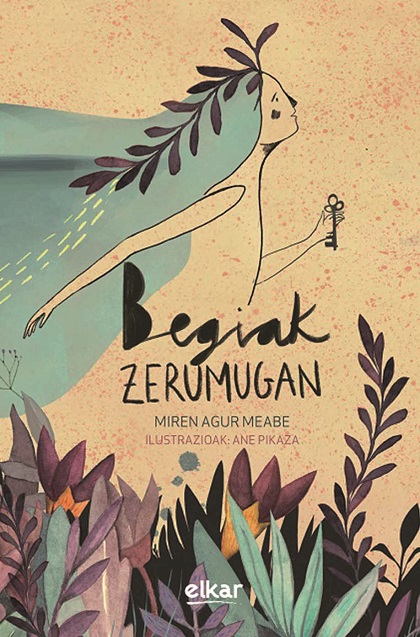

Begiak zerumugan
Idazlea: Miren Agur Meabe
Ilustratzailea: Ane Pikaza
Elkar, 2020
-------------------------------------------------------
Askotariko testuak eta liburuak argitaratu ditu Miren Agur Meabek. Literatur genero guztiekin aritu da: haur eta gazte literatura, autofikzioa, eleberria, ipuinak, poesia... eta batzuetan klasifikatzeko gaitzak diren liburuak ondu ditu, gaurkoan aztertuko dugun Begiak zerumugan kasu.
Haur eta gazteentzat idatzitako poesia ilustratua dela esango banu egia izango litzake, baina, aldi berean, motz geratuko nintzakeela uste dut. Alde batetik, haikuek, lo kantek, ahozkotasunetik gertu dauden poemek, aforismoek osatzen baitute liburua (besteak beste), nortasun propioa eta sakona emanda liburuari. Beste alde batetik, Ane Pikazak testuetako irudi eta sinboloak ezin hobeto jasotzeaz gain, istorioaren haria bere egin eta arintasuna beste detaile eman dizkiolako (horma-irudia dauka gehigarri).
Begiak zerumugan ezartzen dizkigu Meabek hasiera hasieratik, protagonistak zerumugarantz egingo duen bidaiaren testigu izango baita irakurlea: txikitasunetik handitasunera egiten duena, ezinegonetik barne segurtasunera iluntasunetik argitasunera. Heroiaren bidaia moduko bat da finean.
Bidaia hau lau atalek, sarrera poema batek eta laburpen batek osatzen dute. Sarrerako poemak (haize arrosaren mezua) liburuan aurkituko ditugun lau atalak aurreratzen dizkigu. Har ezazu fardela da lehenengoa eta protagonistaren barne mundua, emozioak jasotzen ditu (adorea, poza, etsipena eta abar). Argi- itzaletan mela atalean bidaia zailtzen duten kanpo agenteak dira protagonistak: bidaiaren gora beherak (bidea, labirintoa norabidea…) eta klimatologiarekin lotutakoak (elurpean, putzuak…). Hirugarren atalean barruko uhartea aurkituko du protagonistak (Panpina, irlako etxea). Eta Arimaren arbela den zeruak emango dio kontenplaziorako ezpazioa (Zeruaren azalak, nire galaxia, ilargi amandrea). Laugarrena eta azkena da Han-hemen marinela, espazio zabalak eta naturaren presentzia dira kontu aipagarriak. Kapitulu honetan aurkitzen du protagonistak nire neure etxea, sosegua. Bukatzeko, laburpen poemak errematatzen, borobiltzen du liburua.
Klasifikatzeko zaila den liburua izateak liburua berezi egiten du; kutixi bat da, opari bikaina. Hizkuntza aldetik (lexiko zein sintaxian) aberatsa eta jostaria, literatur baliabide aldetik distiratsua, forma aldetik anitza, ilustrazio aldetik magikoa eta magnifikoa. Baina neure buruari galdetzen diot klasifikatzeko zaila izateak linbo batean utzi ez ote duen materiala. Honako hau ez dadila izan liburuari egiten zaion literatur kritika bakarra. Dabilela liburua eskutik eskura.